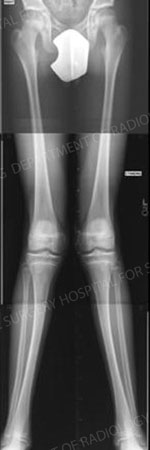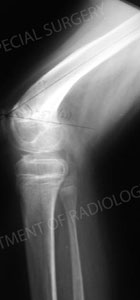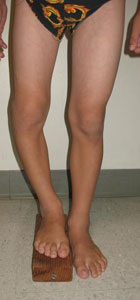Limb (Leg) Deformity Reconstruction for the Pediatric Patient
An interview with HSS surgeons about bowlegs (Blount's Disease / tibia vara), knock knees, and growth plate injuries
- Limb deformities of the leg
- Bowlegs
- Knock knees
- Growth plate injuries – A major cause of limb deformity
Limb deformities of the leg
In growing children, limb deformities of the legs are among the most frequent causes for a visit to the pediatric orthopedist. Both bowing of the legs, in which the knees are abnormally separated, and knock knees, in which the knees are abnormally close together, may first be noticed by a family member during early childhood. In many cases the alignment of the legs corrects naturally. However, in those cases where the condition persists or the abnormality becomes more pronounced, medical attention is required.
Bowlegs
Up until the age of two, bowing of the legs (bowlegs) is not unusual. “In fact,” explains Roger F. Widmann, MD, Chief of Pediatric Orthopedic Surgery at Hospital for Special Surgery (HSS), “there’s a very broad spectrum of what’s considered normal.” The generic term “physiologic genu varum” is used to describe this condition.
Blount's disease
Children aged two and up may be diagnosed with a bowleg deformity such as Blount’s disease or tibia vara. Depending on the age at diagnosis, a child may have the infantile or adolescent type of the disease. Children with the infantile form of the disease are often early walkers; obesity is frequently a factor, irrespective of the patient’s age.
Causes of Blount's disease
Causes of Blount’s disease includes metabolic disorders such as rickets, renal failure, infection, skeletal dysplasias (developmental abnormalities), and achondroplasia (a form of dwarfism). Most commonly, the deformity is found at the top of the tibia, which is the larger of the two bones in the lower leg; the deformity occurs when the lateral (outer) side of the tibia continues growing while the medial (or inner) side of the bone does not. Blount’s disease may affect one or both legs.
Diagnosis of Blount's disease
A diagnosis of Blount’s disease is based on physical examination and a standing alignment X-ray, in which an image of the leg – from hip to ankle – is obtained. The pediatric orthopedist uses this image to determine the mechanical axis of the deformity as well as its location.
Treatment of Blount's disease
The initial treatment for infantile Blount’s disease is bracing, usually for a period of up to one year to determine effectiveness. Standard bracing protocol involves use of a brace during waking hours with the knee in full extension during weightbearing.
If gradual correction does not occur, surgery may be recommended. “Results of surgery for this deformity are much better before age four than after, when the recurrence rate of bowing goes up,” says Dr. Widmann.
In surgical correction of Blount’s disease, the pediatric orthopedist performs an osteotomy, cutting the tibia and fibula as close to the growth plate as possible and realigning the bones. Following the procedure, the surgeon places a fixator on the leg to maintain proper alignment during the healing process.
In acute (severe) correction, a monolateral or single-lane fixator is used. If the correction is gradual, a circular fixator (also called the Ilazarov) is used. This fixator is also used when additional procedures are done simultaneously to correct other deformities such as limb length discrepancy. The latter can develop when Blount’s disease affects only one leg. “In most cases, we do gradual correction with frames that allow for fine-tuning,” Dr. Widmann says. “If the deformity correction is not absolutely perfect on X-ray, we can continue to correct it until it is.”
Rehabilitation for Blount's disease
The fixator is worn for between 8 and 12 weeks as the leg heals. Physical therapy is an important part of treatment and most patients continue to see their therapists three times a week after leaving the hospital. Physical therapy helps ensure that the surrounding soft tissues remain flexible as the bone heals, and that muscle strength is maintained.
Treatment for adolescent Blount’s disease
The initial treatment for patients with adolescent Blount’s disease is usually guided growth, in which the pediatric orthopedic surgeon places a small plate and two screws against the lateral side of the tibia in order to limit growth on this side, while allowing growth on the medial side. As the patient’s natural growth occurs, the deformity is progressively corrected.
If guided growth fails to correct the deformity, or if the patient doesn’t have enough growth left to achieve the desired correction, osteotomy may be recommended. Patients with adolescent Blount’s disease are likely to have some limb length discrepancy as described above and can have both deformities corrected during surgery. Blount’s disease that is left untreated not only results in progression of the deformity, but also an increased risk of joint arthritis of the knee and other early degenerative changes.
Knock knees
As with bowleg deformity, knock knee deformity or genu valgum may be caused by a number of different conditions including metabolic diseases, renal failure, trauma and infection. It may also be idiopathic, that is, having no known cause.
Treatment usually consists of guided growth, rather than osteotomy, with the plate and screws placed on the medial side of the knee – the opposite side from that used to correct bow leg deformity. The specific device used to achieve guided growth is the Eight Plate, which consists of a small, two-hole figure eight plate and two screws, one on each side of the growth plate.

Case Study: a 13 year old male diagnosed with knock knee deformity. (pdf)
Growth plate injuries – A major cause of limb deformity
In children with growth deformities other than bow leg or knock knees, growth plate injuries constitute a major cause, with the most common fractures affecting the proximal tibia and distal femur.

Case Study: a 14 year old female presenting with a growth plate injury. (pdf)
Because the growth plate is the area where new bone develops (adding length to the bone), injury to this area can result in growth arrest and subsequent limb length discrepancy, in which one leg is longer than the other.
Diagnosis of growth plate injuries
Growth plate injuries are generally clear on X-ray, but advanced imagery, specifically MRI, is sometimes required, according to Dr. Widmann. Researchers at HSS are currently studying its application in these injuries; advantages include earlier diagnosis of growth arrest and three-dimensional localization of the area.

Case Study: a 10 ½ year old male with limb discrepancy. (pdf)
Treatment of growth plate injuries
Fractures involving growth plate injuries usually require anatomic reduction, or alignment and fixation. Most children respond well to these procedures, but a small percentage may go on to develop partial or complete growth arrest.
Since there is no way to regenerate the growth plate cartilage after a partial growth arrest, additional interventions may include resection of the partial growth arrest (also known as the physeal bar) or sequential lengthening procedures during childhood. For more information on limb lengthening, please read Limb Lengthening for the Pediatric Patient.
In children near the end of growth with complete growth arrest on one side, the pediatric orthopedic surgeon may recommend closing the growth plate on the other side in order to ensure that the length of the healthy limb matches that of the affected one.
Learn more about Pediatric Limb Deformity Reconstruction at HSS.
Summary prepared by Nancy Novick
References
- Demonstrating High Efficacy. HSS J. 2017 Oct;13(3):255-262. doi: 10.1007/s11420-017-9549-5. Epub 2017 Apr 3. PMID: 28983218; PMCID: PMC5617815.
- Friend L, Widmann RF. Advances in management of limb length discrepancy and lower limb deformity. Curr Opin Pediatr. 2008 Feb;20(1):46-51. doi: 10.1097/MOP.0b013e3282f35eeb. PMID: 18197038.
- Goodbody C, Kedem P, Thompson M, Do HT, Mintz DN, Widmann RF, Dodwell ER. Reliability and Reproducibility of Subject Positioning with EOS Low-Dose Biplanar X-ray. HSS J. 2017 Oct;13(3):263-266. doi: 10.1007/s11420-017-9548-6. Epub 2017 Mar 1. PMID: 28983219; PMCID: PMC5617814.
- Garner MR, Dow M, Bixby E, Mintz DN, Widmann RF, Dodwell ER. Evaluating Length: The Use of Low-dose Biplanar Radiography (EOS) and Tantalum Bead Implantation. J Pediatr Orthop. 2016 Jan;36(1):e6-9. doi: 10.1097/BPO.0000000000000425. PMID: 25955169.
- McLawhorn AS, Sherman SL, Blyakher A, Widmann RF. Humeral lengthening and deformity correction with the multiaxial correction system. J Pediatr Orthop B. 2011 Mar;20(2):111-6. doi: 10.1097/BPB.0b013e328341bc87. PMID: 21099438.


